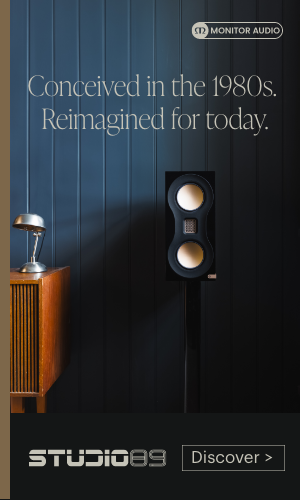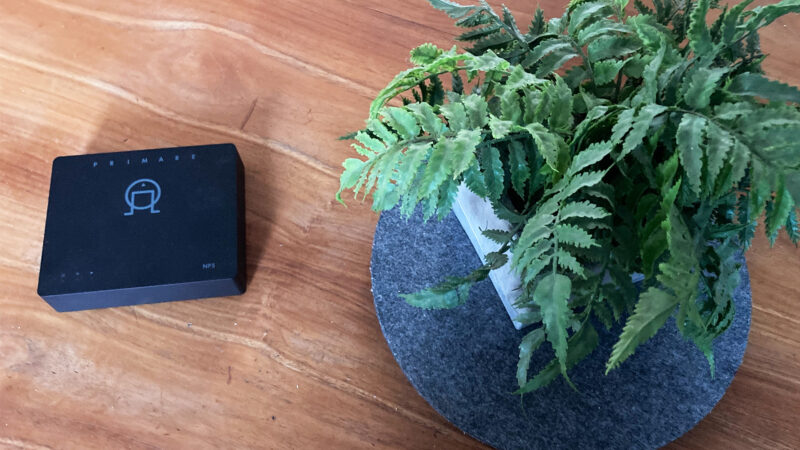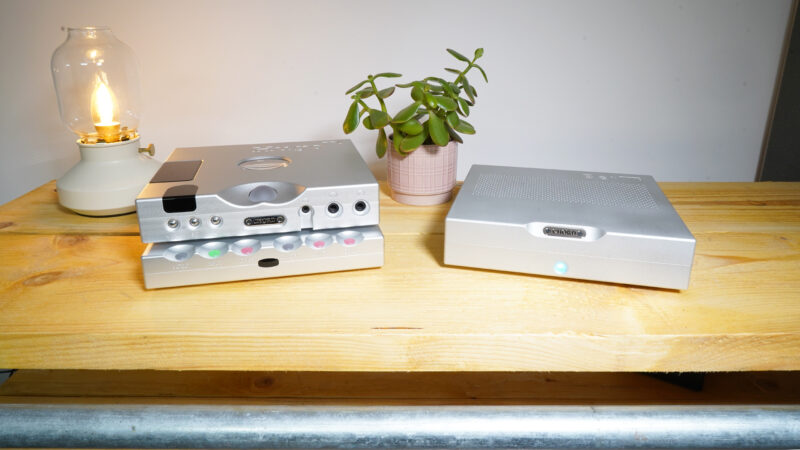The Volumio Rivo streaming transport is one of the most flexible networked music solutions I’ve tried. Launched in 2022, the Rivo isn’t the Italian maker’s newest streaming model, but is a purist audio approach to networked music with all the benefits of the company’s extensive customisation control (via the robust Volumio app), and impressive system integration capabilities.
As an older model, Volumio’s Rivo media player doesn’t match the eye-catching standards of its lifestyle-led Motivo streaming solution that it launched in May 2024 at £1,499. The Rivo certainly looks dull by comparison, but it’s deceptively adaptable with a similar level of hi-end audio capabilities and control smarts as the flagship model. and at £849 it costs considerably less. Okay, Rivo buyers don’t get a built-in DAC or the iPad-esque 8-inch display of the Motivo, but it’s a surprisingly flexible networked media player with full hi-res format support for audio aficionados looking to bring extensive streaming capabilities to a hifi setup.
Custom control
For anyone new to Volumio, the Florence-based audio specialist was founded in 2015 on the back of open-source software development, built to run on devices such as Raspberry Pi. Today, Volumio’s operating system is available for download on Raspberry Pi and PC in Standard (free) and Premium (£6.49/month) subscription plans. Volumio OS subscribers can integrate music libraries from a home network, USB storage, or any streaming service, and control and customise depending on the Volumio platform plan they’re signed up to.
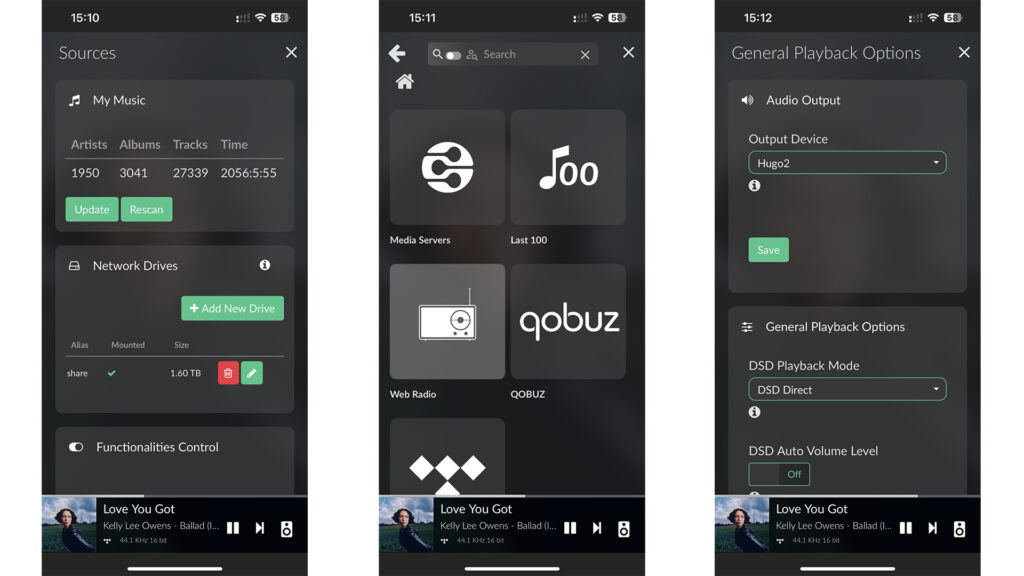
Rivo owners get access to Volumio’s Premium subscription plan for free, with multiroom control, AI playback, album and artist info/credit discovery, as well as native Tidal, Qobuz and HighResAudio integration
As a hardware audio device, the Rivo connects to a home network over Ethernet or wifi and supports AirPlay (via Shairport Sync) and UPnP DLNA connected devices. Owners also get free access to Volumio’s Premium plan with full customisation tools and features. This enables streaming to Sonos speakers and components, as well as Chromecast and multiroom support with other Volumio products. There are even CD playback/ripping capabilities. The Rivo is also Roon Ready certified, meaning it can seamlessly integrate with a Roon Core music library. The Volumio control app is available for both iOS and Android devices, and the installation process ran smoothly.
Pump up the Volumio
As a former Hi-Fi Choice magazine editor, I was introduced to Volumio when the company launched its original Primo hifi streaming DAC in 2019. The company has been busy building its hardware portfolio in the intervening years, and the Rivo streaming transport currently sits between two similarly-styled networked audio solutions — the Integro all-in-one streaming amplifier (£1,049) and the second-gen Primo music streamer and DAC (£679).
More recently, Volumio introduced the Lineo5 low-noise 5V/5A linear power supply (£349) dedicated to enhancing the performance of its streamers (or any 5V audio device). It has support for both 110V and 220V AC inputs and provides a practical upgrade path for anyone looking to improve on the Rivo’s wall wart power supply with a solution designed to meet the transient response requirements and demands of high-quality audio signals. A Volumio Lineo5 was supplied in time for my Rivo review.
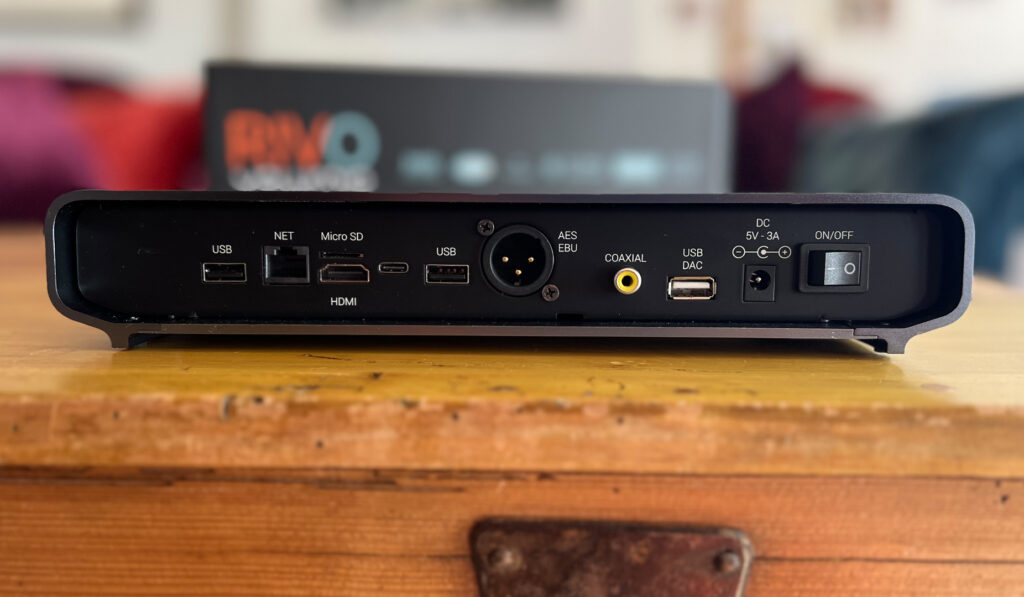
Turn the Rivo around and the unassuming outward design yields a plethora of digital connectivity, including an Ethernet port, microSD slot and USB ports for external drives, HDMI, USB-A (with DSD256 support), coaxial and AES/EBU XLR (both with 24-bit/192kHz support). Built-in antennas take care of wireless connectivity over wifi and Bluetooth
Digital powerhouse
The Rivo measures just 5 x 27 x 15cm (HxWxD). The unit feels solidly built and I like the wraparound aluminium case that comes in ‘Classic’ (silver) as well as a limited edition black finish. There’s no display, just a single copper-coloured button at the centre of the front panel (the button is coloured silver on the black version). Despite the outward minimalism of the front panel, there’s a plethora of digital audio connectivity options to choose from at the back, including a USB DAC port (with power filtering), coaxial, and AES/EBU digital outputs. Bluetooth 5.0 connectivity is also supported.
Much like Primare’s NP5 Prisma Mk2, the Rivo is a streaming transport only, meaning it doesn’t have a built-in DAC or perform amplification duties. To convert the Rivo’s digital signals to analogue, you’ll therefore need to connect it to a capable DAC. You may have one in your hifi setup already (built into the preamp perhaps), or look to add one of our high-end recommendations such as the recently reviewed Chord Electronics Hugo TT 2 table-top preamp/DAC/headphone amp (£3,995).
If that’s too steep, alternatives include the iFi Audio iDSD Diablo 2 (£1,299) — which arrived around the same time as the Rivo (look out for my full review on these pages soon) — or I recommend Chord Electronics’ Qutest standalone DAC (£1,195) as well as either of the company’s versatile portable DACs including the Mojo 2 (£395) and Hugo 2 (£1,795).
I’ve had considerable experience with Chord DACs over the years, and either will take the Rivo’s digital output and convert it into a joyous analogue signal perfectly suited to any line-level input on a hifi amplifier. In fact, the Hugo 2 portable USB DAC/headphone amp is my go-to choice for running DAC duties in my regular hifi setup and converts digital audio signals into analogue ones with such grace. As well as the music joy it brings to my hifi setup, I am a sucker for those eye-catching coloured status lights too.
Pure tones
While the Rivo’s demure style and missing DAC undoubtedly help to keep the price competitive, audio signal integrity is a priority. In fact, Volumio says that its sonic architecture and simplicity maintains a pure digital signal path to achieve a listening experience without compromise.
That said, audio file format handling runs to DSD256, WAV, FLAC, ALAC, AAC, Vorbis, and MP3 (among others), with the likes of Tidal, Tidal Connect, Qobuz, and HighResAudio streaming services installed as part of the Volumio OS Premium plan. Further plugins for Spotify and Spotify Connect can be installed as well as services including YouTube, Squeezelite, Radio Paradise, Podcasts, Pandora, Soundcloud and Mixcloud music services. There’s also a FusionDSP audio interface plugin with 15-band EQ and audio filtering, should you feel inclined.
Initially developed for computer audio file playback with streaming service support added at a later date, the Volumio system presents your music library in an attractive and easy to navigate way and comes with some useful additional tools. Volumio AI is a powerful supersearch tool that optimises your music discovery experience, while Infinity Playback delivers an endless stream of tracks from your music library to match a mood.
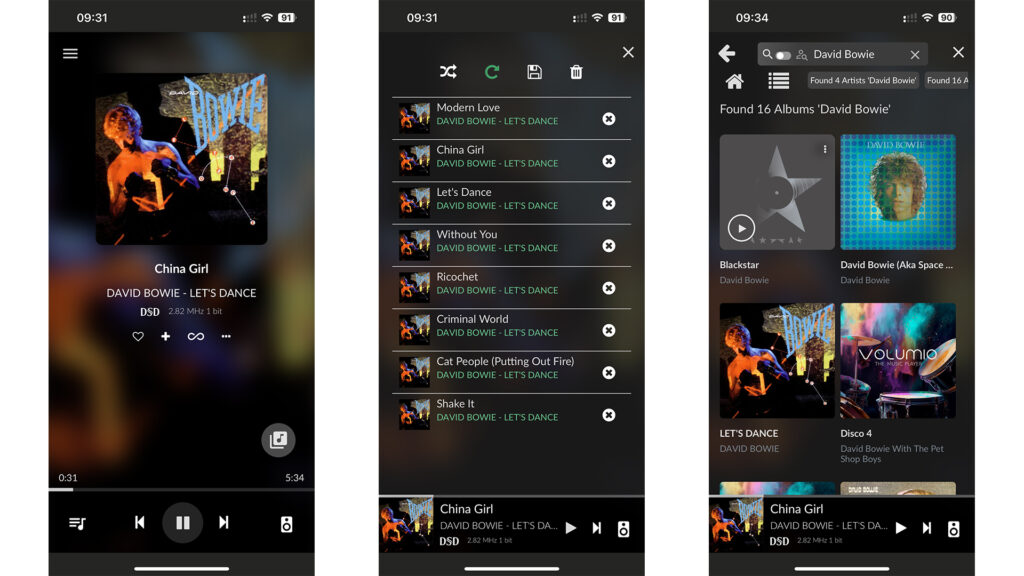
Rivo owners get access to Volumio’s Premium subscription plan for free, with multiroom control, AI playback, album and artist info/credit discovery, as well as native Tidal, Qobuz and HighResAudio integration
There were some glitches with the control app that meant it needed to be restarted several times while tailoring it to my system during the initial stages, but this appeared to settle down as I became more familiar with navigating it.
Also, despite being prompted to register my details with Volumio as part of the installation process, my login failed to be recognised during my early attempts. Registering at a later date seemed to overcome the hiccup, and a Volumio representative told me there’s a new app designed to rectify these issues in the works for the end of 2024.
Performance
There are plenty of digital output options to connect the Rivo to the DAC of your choice, but I opted for the suggested USB DAC port linked to a Chord Electronics Hugo 2 and was immediately impressed by just how superior the combo sounded together. With the Volume Options set to None in the Rivo’s General Playback Options menu, the pairing delivered my digital music collection with great precision and insight.

Pairing the Volumio Rivo with the Chord Electronics Hugo 2 DAC achieved one of the most enjoyable music encounters I’ve experienced on my setup at home
With more than 30 years in the audio industry, I’ve been fortunate enough to attend several hi-end audio demos in some of the best listening rooms in the world. Many have been sonically satisfying experiences and hard to match in my own living/listening room. So it’s rare for me to experience the extraordinary rush of adrenaline I got when listening to my favourite music tracks played out by the Rivo streaming transport for the first time on my system at home. But as I sat on my sofa listening to my go-to Tidal playlist, I was spellbound by the level of insight and musical flair the Rivo transport (powered by the Lineo5 power supply) brought to tracks I’ve heard hundreds of times before.
Whether that’s down to the USB DAC port’s power filtering and dedicated clock capabilities is hard to say, but the Rivo gave a superior listening experience when connected in this way. While the S/PDIF output sounded pretty great too, I found it had a little less musical flair.
As such, I found myself digging deep into the music library stored on my Melco drive, revisiting classic albums I’ve not listened to in a while. Everything from David Bowie’s Let’s Dance (DSD64) to Pink Floyd’s The Dark Side Of The Moon (24-bit/88.2kHz FLAC) and Wings’ Band on the Run (24-bit/96kHz FLAC) sounded coherent and more skilfully recorded than I remembered. I could hear right into the mix of each recording, with vocals seemingly lifted and more distinct from the background. It’s not that they sounded any louder, just more tangible. Instruments soared and sounded fluid, and individual music strands felt defined and easy to follow.
With the Rivo as the digital front-end, the system sounded somehow more powerful yet natural at the same time. The soundstage felt exciting and three-dimensional, and got surprisingly close to the nirvana moments I’ve experienced at the best hifi demos.
In Summary
With a superb level of system integration and customisation, the Volumio Rivo is one of the best networked music streaming experiences I’ve encountered with my system at home. This was a surprise to me given that the Rivo isn’t doing anything other than handling the digital data stream from whatever music library selected. Even so, I’m convinced there was more engagement in the way the Rivo presented my music, and I’d wager that it helped the DAC sound even better, bringing expressive realism to instruments and vocal performances. Now who doesn’t want that from their hifi setup?
Add in Volumio’s Lineo5 linear power supply designed to ensure the requirements of even the most demanding audio signals are met, and you have a smart streaming front-end with high-end audio credentials to rival models costing twice as much.



